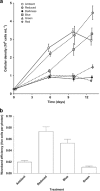In situ light responses of the proteorhodopsin-bearing Antarctic sea-ice bacterium, Psychroflexus torques
- PMID: 28524871
- PMCID: PMC5563954
- DOI: 10.1038/ismej.2017.65
In situ light responses of the proteorhodopsin-bearing Antarctic sea-ice bacterium, Psychroflexus torques
Abstract
Proteorhodopsin (PR) is a wide-spread protein found in many marine prokaryotes. PR allows for the potential conversion of solar energy to ATP, possibly assisting in cellular growth and survival during periods of high environmental stress. PR utilises either blue or green light through a single amino acid substitution. We incubated the PR-bearing bacterium Psychroflexus torquis 50 cm deep within Antarctic sea ice for 13 days, exposing cultures to diurnal fluctuations in light and temperature. Enhanced growth occurred most prominently in cultures incubated under irradiance levels of ∼50 μmol photons m-2 s-1, suggesting PR provides a strong selective advantage. In addition, cultures grown under blue light yielded over 5.5 times more live cells per photon compared to green-light incubations. Because P. torquis expresses an apparently 'green-shifted' PR gene variant, this finding infers that the spectral tuning of PR is more complex than previously thought. This study supports the theory that PR provides additional energy to bacteria under sub-optimal conditions, and raises several points of interest to be addressed by future research.
Conflict of interest statement
The authors declare no conflict of interest.
Figures

 ), complete darkness (
), complete darkness ( ), reduced photosynthetically active radiation (
), reduced photosynthetically active radiation ( ), blue (
), blue ( ), green (
), green ( ) or red light (
) or red light ( ). Data points are offset (±3 h) for ease of viewing. Following incubation for 6, 10 or 13 days, 2 ml samples were fixed in 1% formaldehyde (Sigma-Aldrich, Auckland, New Zealand) and stored at −20 °C. After thawing, 1 ml of each was centrifuged (5000 g, 12 min), and the pellets air dried for ∼10 min. Cells were re-suspended in 350 μl of 0.22 μm filtered phosphate buffered saline (Life Technologies, Auckland, New Zealand) diluted 10 × and 350 μl was transferred to a 5 ml tube containing 35 μl of TruCount bead solution (Becton Dickinson). Each sample was incubated at room temperature for 15 min in 3 μ
). Data points are offset (±3 h) for ease of viewing. Following incubation for 6, 10 or 13 days, 2 ml samples were fixed in 1% formaldehyde (Sigma-Aldrich, Auckland, New Zealand) and stored at −20 °C. After thawing, 1 ml of each was centrifuged (5000 g, 12 min), and the pellets air dried for ∼10 min. Cells were re-suspended in 350 μl of 0.22 μm filtered phosphate buffered saline (Life Technologies, Auckland, New Zealand) diluted 10 × and 350 μl was transferred to a 5 ml tube containing 35 μl of TruCount bead solution (Becton Dickinson). Each sample was incubated at room temperature for 15 min in 3 μSimilar articles
-
Light-stimulated growth of proteorhodopsin-bearing sea-ice psychrophile Psychroflexus torquis is salinity dependent.ISME J. 2013 Nov;7(11):2206-13. doi: 10.1038/ismej.2013.97. Epub 2013 Jun 20. ISME J. 2013. PMID: 23788334 Free PMC article.
-
Proteorhodopsin-bearing bacteria in Antarctic sea ice.Appl Environ Microbiol. 2010 Sep;76(17):5918-25. doi: 10.1128/AEM.00562-10. Epub 2010 Jul 2. Appl Environ Microbiol. 2010. PMID: 20601510 Free PMC article.
-
Proteomic Insight into Functional Changes of Proteorhodopsin-Containing Bacterial Species Psychroflexus torquis under Different Illumination and Salinity Levels.J Proteome Res. 2015 Sep 4;14(9):3848-58. doi: 10.1021/acs.jproteome.5b00241. Epub 2015 Jul 30. J Proteome Res. 2015. PMID: 26179671
-
Marine Bacterial and Archaeal Ion-Pumping Rhodopsins: Genetic Diversity, Physiology, and Ecology.Microbiol Mol Biol Rev. 2016 Sep 14;80(4):929-54. doi: 10.1128/MMBR.00003-16. Print 2016 Dec. Microbiol Mol Biol Rev. 2016. PMID: 27630250 Free PMC article. Review.
-
Bacterial exopolysaccharides from extreme marine environments with special consideration of the southern ocean, sea ice, and deep-sea hydrothermal vents: a review.Mar Biotechnol (NY). 2005 Jul-Aug;7(4):253-71. doi: 10.1007/s10126-004-5118-2. Epub 2005 Jul 21. Mar Biotechnol (NY). 2005. PMID: 16075348 Review.
References
-
- Arrigo KR, Worthen DL, Lizotte MP, Dixon P, Dieckmann G. (1997). Primary production in Antarctic sea ice. Science 276: 394–397. - PubMed
-
- Béjà O, Aravind L, Koonin EV, Suzuki MT, Hadd A, Nguyen LP et al. (2000). Bacterial rhodopsin: evidence for a new type of phototrophy in the sea. Science 289: 1902–1906. - PubMed
-
- Béjà O, Spudich EN, Spudich JL, Leclerc M, DeLong EF. (2001). Proteorhodopsin phototrophy in the ocean. Nature 411: 786–789. - PubMed
-
- Bowman JP, McCammon SA, Lewis T, Skerratt JH, Brown JL, Nichols DS et al. (1998). Psychroflexus torquis gen. nov., sp. nov. a psychrophilic species from Antarctic sea ice, and reclassification of Flavobacterium gondwanense (Dobson et al. 1993) as Psychroflexus gondwanense gen. nov., comb. nov. Microbiology 144: 1601–1609. - PubMed
MeSH terms
Substances
LinkOut - more resources
Full Text Sources
Other Literature Sources
Research Materials

